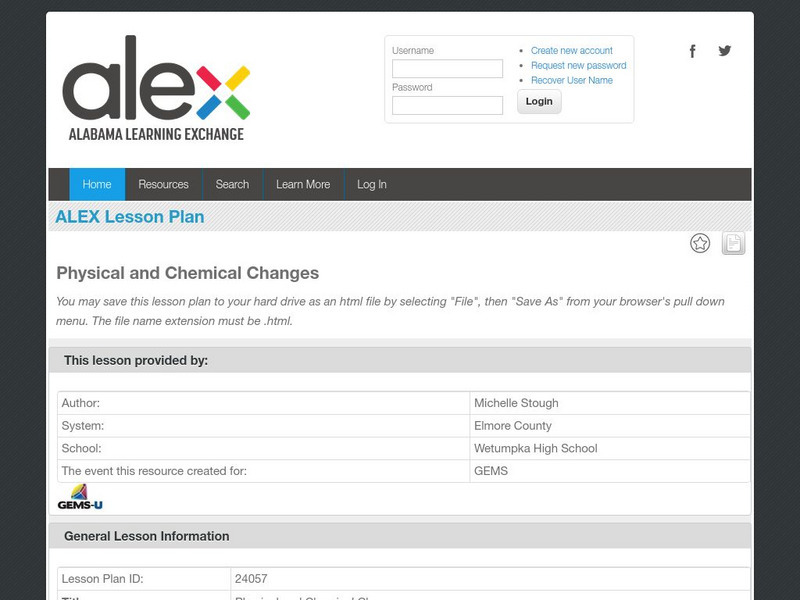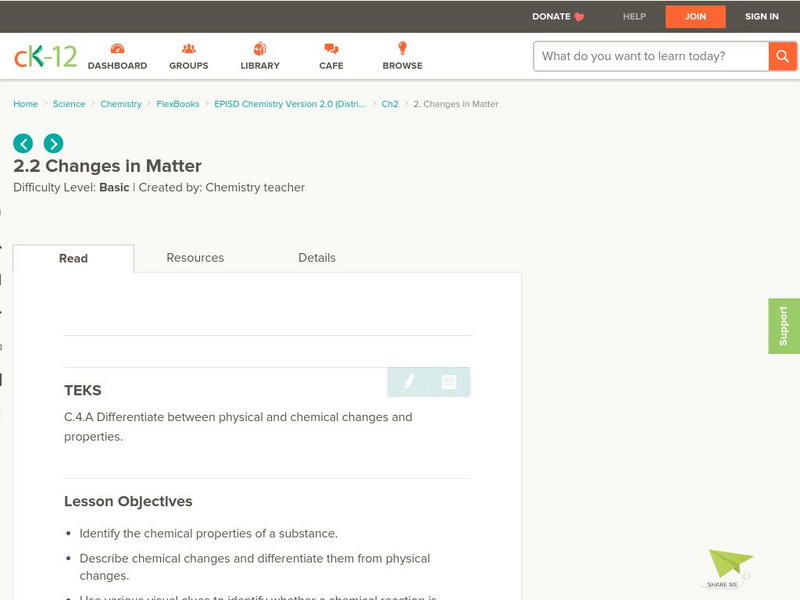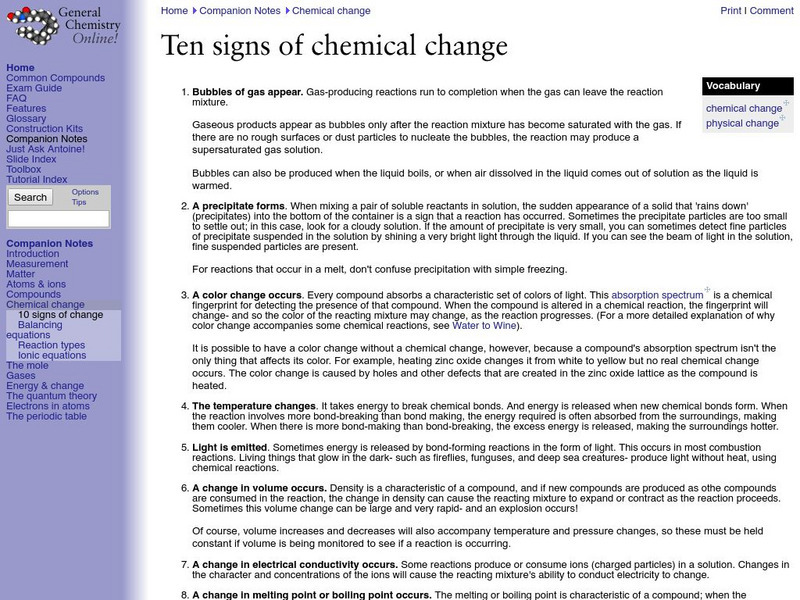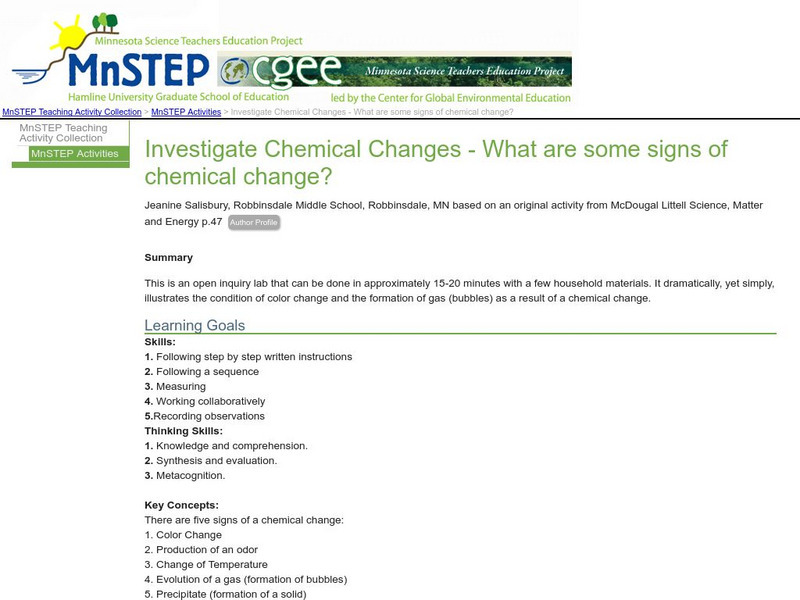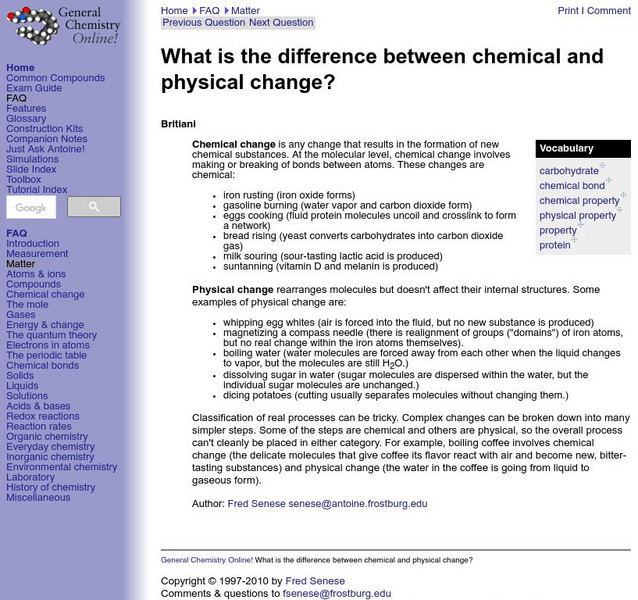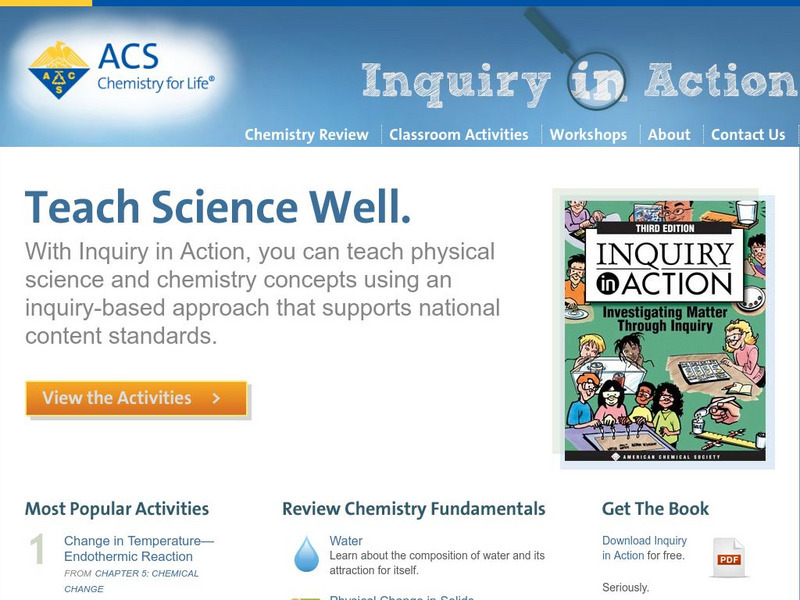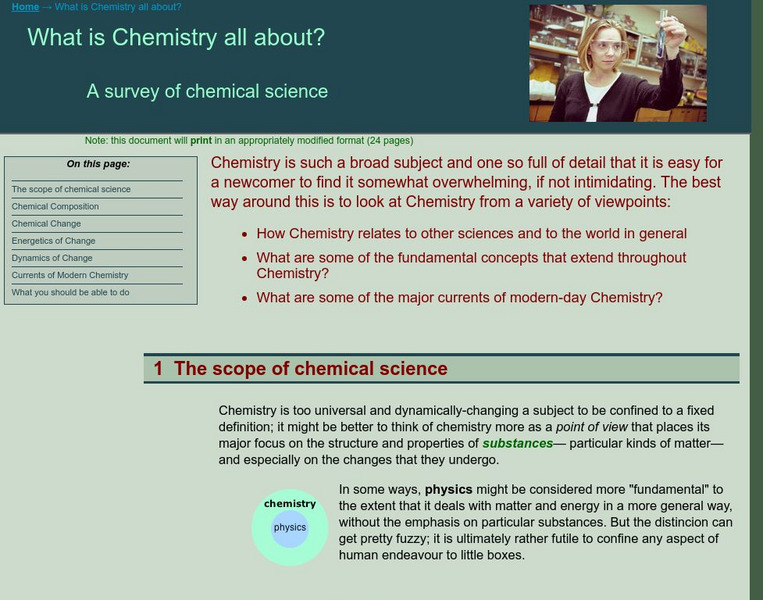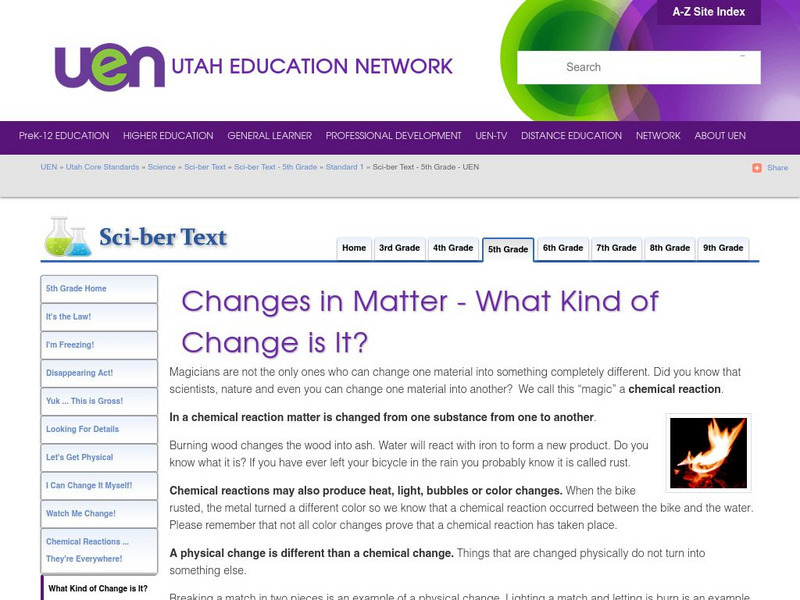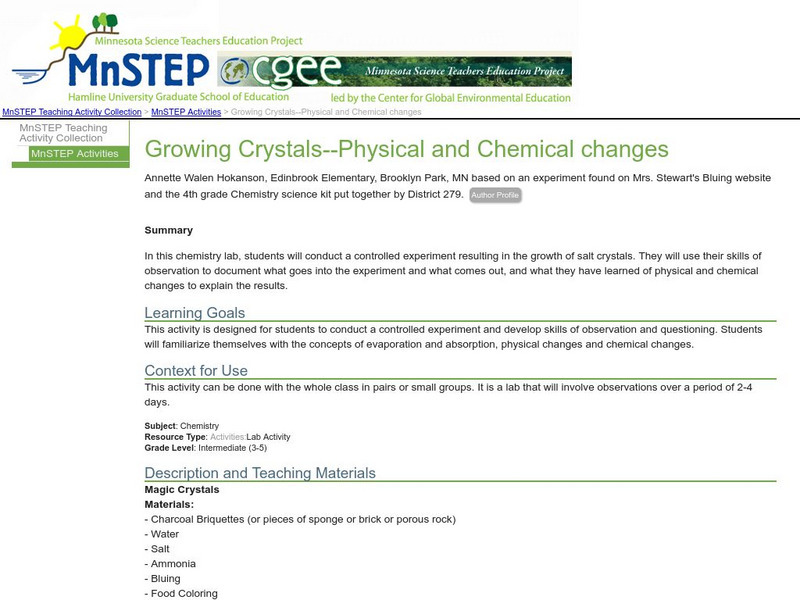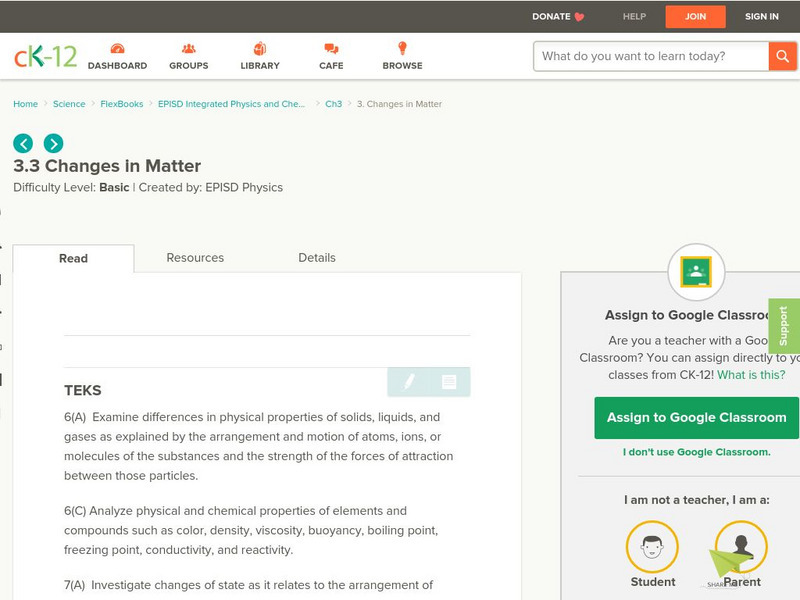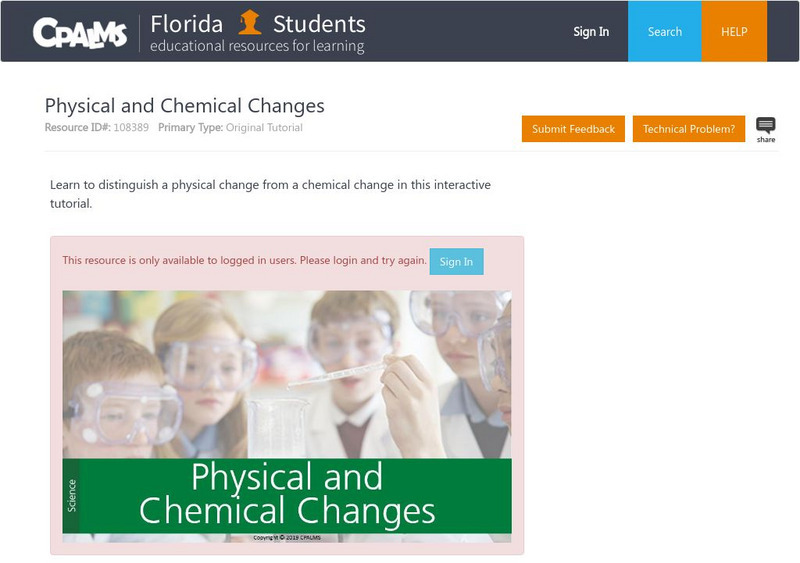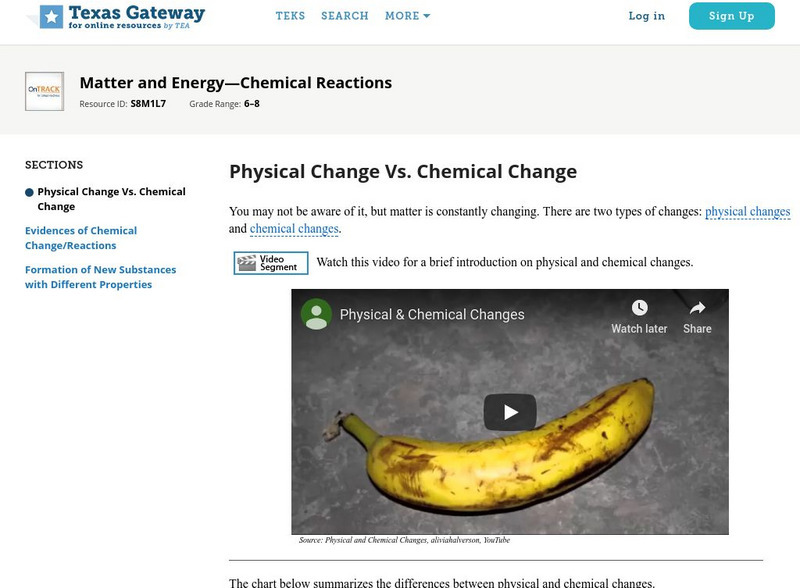Hi, what do you want to do?
Alabama Learning Exchange
Alex: Physical and Chemical Changes
The teacher will conduct the whoosh bottle demonstration to engage students. The class will then begin discussion of endothermic and exothermic physical and chemical changes. The students will then conduct the Science in Motion lab...
CK-12 Foundation
Ck 12: Changes in Matter
[Free Registration/Login may be required to access all resource tools.] In the following online tutorial students identify the chemical properties of a substance and describe chemical changes and differentiate them from physical changes....
American Chemical Society
Middle School Chemistry: Lesson Plans: Using Chemical Change to Identify Unknown
Students observe reactions of liquids with different known powders in this lesson. Unknown powders are then identified using characteristic chemical changes.Site includes a procedure, teacher instructions, and video instruction.
American Chemical Society
Inquiry in Action: Using Chemical Change to Identify an Unknown
This activity explores how students could use chemical changes to identify unknown substances. Lab activity includes student and teacher worksheets.
American Chemical Society
Middle School Chemistry: Chapter 6: Chemical Change
Twelve interactive chemistry lessons about chemical changes complete with handouts and animations.
Frostburg State University
General Chemistry Online: Ten Signs of Chemical Change
Resource provides the ten signs that tell when a chemical change has occured. Each sign has a detailed explanation.
Science Education Resource Center at Carleton College
Serc: Investigate Chemical Changes: What Are Some Signs of Chemical Change?
This lab illustrates the condition of color change and the formation of gas (bubbles) as a result of a chemical change. Students will be able to name the characteristics of chemical changes.
Science Education Resource Center at Carleton College
Serc: Chemical Changes: Reacting an Acid and Base
In this chemistry lab, students will investigate chemical changes that occur when acids and bases react. It is meant to introduce the concepts of chemical changes, gases have mass, conservation of mass, and balancing equations. Students...
Frostburg State University
General Chemistry Online: Physical and Chemical Changes
Resource provides information about the difference between physical and chemical changes. Includes a definition and examples of each.
ArtsNow
Arts Now Learning: Using Tableau to Explore Physical & Chemical Changes [Pdf]
In this lesson plan, 5th graders explore how to use tableaux to dramatize physical and chemical changes, and add dialogue to the tableaux to support their argument of whether the change is physical or chemical.
Science Struck
Science Struck: Chemical Change Examples That We See Around Us
Explains what a chemical change is and how to identify one. Provides examples of chemical changes that are often seen in organic and inorganic compounds.
American Chemical Society
American Chemical Society: Inquiry in Action: Teach Science Well
Online textbook reviews fundamentals of chemistry and physical science via slideshow presentations, notes, and videos. Materials for classroom activities engage students in inquiry-based, hands-on investigations covering molecular...
American Chemical Society
American Chemical Society: Inquiry in Action: Teach Science Well
Online textbook reviews fundamentals of chemistry and physical science via slideshow presentations, notes, and videos. Materials for classroom activities engage students in inquiry-based, hands-on investigations covering molecular...
Simon Fraser University
Chem1 Virtual Textbook: Chemical Change
Chemical change is a section of a larger overview on Chemistry, covering a variety of aspects. This section focuses on chemical change including the difference between chemical change and physical change.
CK-12 Foundation
Ck 12: Fifth Grade: Physical Science: Physical and Chemical Changes in Matter
[Free Registration/Login may be required to access all resource tools.] Provides the definitions of physical and chemical changes in matter and gives examples. The law of conservation of mass is also described.
Utah Education Network
Uen: Changes in Matter What Kind of Change Is It?
Can you distinguish physical changes from chemical changes? After reading a brief summary of both types of changes, you'll be presented with some examples and asked to identify them.
Alabama Learning Exchange
Alex: Name That Change!
This lesson teaches students to distinguish between physical and chemical changes. Students will view an interactive slideshow presentation and then conduct experiments to discern physical and chemical changes.
Frostburg State University
General Chemistry Online: Chemical Change Faq
Investigate the answers to many commonly asked questions about chemical change. This comprehensive list will address chemical equations and double displacement reactions in addition to other topics.
Science Education Resource Center at Carleton College
Serc: Growing Crystals Physical and Chemical Changes
Students conduct a controlled experiment resulting in the growth of salt crystals. They will use their skills of observation to document what goes into the experiment and what comes out, and what they have learned of physical and...
Other
Science4 Us: Changes in Matter
Through an instructional video, games, and activities, students explore three types of change matter makes: physical change, in which only the shape of the matter changes; physical phase change in which matter changes to a different form...
CK-12 Foundation
Ck 12: Changes in Matter
[Free Registration/Login may be required to access all resource tools.] Students will describe methods for separating mixtures, such as chromatography, distillation, fractional distillation, evaporation, and filtration. They will also...
ClassFlow
Class Flow: Physical and Chemical Changes
[Free Registration/Login Required] Physical and chemical changes are defined and examples are given of each. Practice with determining the difference between mixtures and solutions are also given. Links to external sites for practice...
CPALMS
Florida State University Cpalms: Florida Students: Physical and Chemical Changes
Explore the differences between chemical and physical changes, including some examples at the atomic level.
Texas Education Agency
Texas Gateway: Matter and Energy: Chemical Reactions
Do you know the difference between a physical and a chemical change? This interactive tutorial will explore these concepts!





